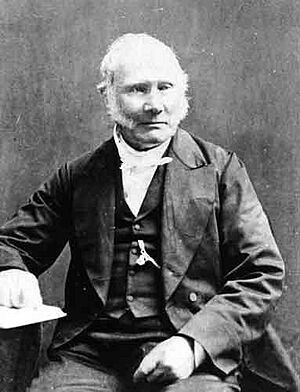Robert Stirling facts for kids
Quick facts for kids
Robert Stirling
|
|
|---|---|
 |
|
| Born | 25 October 1790 Methven, Perthshire, Scotland
|
| Died | 6 June 1878 (aged 87) Galston, East Ayrshire, Scotland
|
| Occupation | Engineer |
| Children | 7, including Patrick Stirling and James Stirling |
| Engineering career | |
| Institutions | University of Edinburgh University of Glasgow |
| Projects | Stirling engine |
Robert Stirling (born October 25, 1790 – died June 6, 1878) was a Scottish minister and engineer. He is famous for inventing the Stirling engine. In 2014, he was honored by being added to the Scottish Engineering Hall of Fame.
Contents
Robert Stirling's Early Life
Robert Stirling was born in a place called Fatal Fields, near the village of Methven in Perthshire, Scotland. He was one of eight children born to Patrick and Agnes Stirling.
His grandfather, Michael Stirling, was known for inventing the threshing machine, which helped farmers. Robert's father, Patrick, also liked to experiment with farm equipment.
Even though Robert was naturally good at engineering, he started studying to become a minister at Edinburgh University when he was 15 years old. His brother James, who later helped Robert with his inventions, also went to Edinburgh University. Robert continued his studies at Glasgow University and then returned to Edinburgh University.
In 1816, Robert became a licensed minister in the Church of Scotland. He worked as a minister in Kilmarnock and then in Galston Parish Church until 1878.
In 1819, Robert Stirling married Jane Rankine. They had seven children together.
Robert Stirling's Engineering and Inventions
The Hot Air Engine
Robert Stirling is known as one of the first people to develop hot air engines. Before him, only a few others, like Guillaume Amontons in 1699, had built working hot air engines.
Stirling's most famous invention is the heat engine, now called the Stirling engine. In 1816, Robert and his brother patented a device called a "Heat Economiser." This invention could store and release heat as air moved through it. This was different from most engines at the time, which used steam.
While working in Kilmarnock, Stirling worked with Thomas Morton, who let him use his workshop. By 1818, Stirling had put his Heat Economiser into an engine that used a closed loop of air to create power. This was a big change from the steam engines that were common back then. This new engine was used to pump water from a quarry.
Stirling's engine worked well, but the metals available at the time were not strong enough. The high pressure of the heated air would eventually crush the air containers.
In 1824, Stirling tried to make his engine better by separating the air inside the economizer. He used thin metal plates for the plungers to improve airflow and help the engine heat and cool better. This idea got a patent, but it didn't make the engine much more efficient.
In 1840, Stirling received another patent for his heat engine after making more changes to make it stronger. He added rods or plates where hot air traveled to the cooler part of the engine. This helped the air cool down more effectively. He also added special leather seals around the piston rods to stop air from leaking out.
After these improvements, Stirling built two of these engines for an iron foundry he managed in Dundee. One engine started working in March 1843 and ran until December 1845, when an air container failed. This was likely because the metals couldn't handle the very high temperatures. After replacing the container a few times, the engine was taken apart in 1847 when Stirling left the foundry.
In 1876, Robert Stirling wrote a letter saying how important Henry Bessemer's new invention, the Bessemer process for making steel, was. Stirling believed that this new, stronger steel would make air engines work much better.
Robert Stirling wanted to make engines safer. His engine was designed to fail less dangerously than the steam engines of his time, and it was also more efficient. Even though the Stirling engine is not used often today, its ability to run almost continuously still interests scientists at places like Los Alamos National Laboratory and NASA.
Robert Stirling's Family and Death
On July 10, 1819, Stirling married Jane Rankine. They had seven children:
- Patrick Stirling, born in 1820, became a locomotive engineer.
- Jane Stirling, born in 1821.
- William Stirling, born in 1822, became a civil engineer in South America.
- Robert Stirling, born in 1824, became a railway engineer in Peru.
- David Stirling, born in 1828, became a minister.
- James Stirling, born in 1835, also became a locomotive engineer.
- Agnes Stirling, born in 1838, became an artist.
Reverend Robert Stirling passed away in Galston, East Ayrshire, on June 6, 1878. He is buried in Galston Cemetery. A new gravestone was put up in December 2014 by people who donated money, replacing his old, damaged one.
Honors and Recognition
On January 11, 1840, the University of St. Andrews gave Stirling the title of Doctor of Divinity for his excellent work as a minister.
On October 3, 2014, Stirling was added to the Scottish Engineering Hall of Fame, recognizing his important contributions to engineering.
Images for kids
See also
- Stirling cycle
- Stirling engine
- Applications of the Stirling engine


